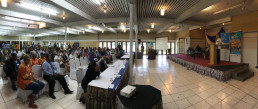
Photo credits: UNDP/Jone Raqauqau
Suva, Fiji – A recent two-day trade fair has shed light on the Development Minerals industry in Fiji and the importance of a better informed and sustainable practice choices for all stakeholders involved.
The event provided a platform for relevant government departments, commercial operators, environment organisations, civil society organisations, financing institutions and resource owners to network. Financing institutions have been widely involved as access to finance is often a challenge for start-up businesses.
The Trade Fair for Development Minerals is an activity under the ACP-EU Development Minerals Programme which is an initiative by the African, Caribbean, and Pacific (ACP) Group of States, coordinated by the ACP Secretariat, financed by the European Union (EU) and United Nations Development Programme (UNDP), and implemented by UNDP. The project is implemented in partnership with the Mineral Resources Department.
Development Minerals’ are materials that are mined, processed, manufactured and used domestically in industries such as in construction, manufacturing, and agriculture. Development Minerals are economically important for the areas surrounding the location where it is mined.
In delivering his opening address, the Permanent Secretary for Lands and Mineral Resources, Malakai Finau highlighted the importance of partnership.
“There is a huge responsibility on all stakeholders, from resource owners, private sector, regulatory agencies and development partners to pool resources together and collaborate more effectively in working towards the common goal of achieving environmental, social and economic balance in the utilisation of Fiji’s vast and diverse mineral resources,” said Finau.
He added, “With the growth of Fiji’s economy over the years, the demand for gravel and sand has escalated with more applications received by the Ministry for rivers and streams gravel/sand extraction licenses on a commercial basis to keep pace with the national infrastructure developments.”
“Taking into consideration the importance of our minerals, the Department recently opened a new Core Repository, which will assist the Government establish a national mineral resource inventory to provide valuable geoscience information to the relevant stakeholders, current and future sector investors, as well as education institutions,” said Finau.
For Fiji, although Development Minerals come under the Quarry Act, itis often confused with High Value Mining that extract metals such as gold, copper, silver etc. ‘’High Value’’ involves different processes and falls under the Mining Act.
In her opening address, the Acting Head of Cooperation of the European Union Delegation for the Pacific, Emmanuelle Guiheneuf, highlighted the importance of the development minerals sector.
“The mining of development minerals has important implications for sustainable development, however, they have not to date received adequate attention for their potential to impact livelihoods and few development programs have provided support for this mining sub-sector,” said Guiheneuf.
She added, “The ACP-EU Development Minerals Project has certainly achieved a lot in the last three years and this includes; the 21 unit curricula with the Fiji National University (FNU) in Mining and Quarrying, established a development minerals working committee with the Minerals Resources Department and stakeholders in the industry, the creation and support for a development minerals working group in the Fiji Parliament, as well as small grants given to resource owners for their start up business.”
In his address, the Country Director, UNDP Pacific Office in Fiji and Head of Pacific Regional Programmes and Policy, Bakhodir Burkhanov, highlighted how development minerals are intrinsic to local and global economies.
“This Trade Fair is therefore a culmination of three years of hard work with many partners to deepen the understanding of Development Minerals among all stakeholders and to help them make better informed and more sustainable choices in the future,” said Burkhanov.
He added, “Development Minerals are all around us, but we often don’t notice them. This is why they are also called Neglected Minerals or Low-Value Minerals. They are too often overlooked but play a pivotal role in our economies. In Fiji, it is estimated that they contribute up to 3.7% of the GDP.”
“Significant scope exists to establish several new Development Mineral industries in Fiji, including; cement produced from local resources, industrial lime, ceramics utilising residual clays, clay bricks, glass production from silica sand resources, industrial salt production, and phosphates.”
“They are the pillar of the construction industry as we need more and higher quality materials to build resilient infrastructure that can withstand the impacts of disasters and climate change, particularly here, in the highly vulnerable Pacific islands,” said Burkhanov.
The Trade Fair for Development Minerals with the theme ‘Building a Rock-Solid Future for Fiji’ was held in Lami, on the 30 and 31 of October.
This story was originally published by UNDP Pacific Office on November 25, 2018
https://www.undp.org/pacific/news/recognising-development-minerals-resilient-development
